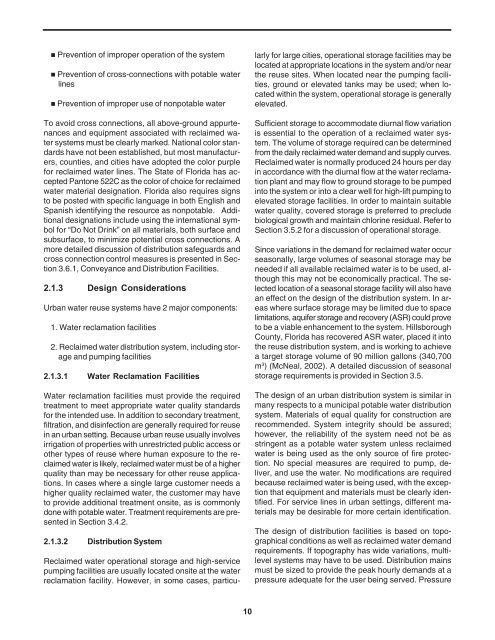o_19f3m1n7k170b14e9u0oqipgu4a.pdf
Create successful ePaper yourself
Turn your PDF publications into a flip-book with our unique Google optimized e-Paper software.
• Prevention of improper operation of the system<br />
• Prevention of cross-connections with potable water<br />
lines<br />
• Prevention of improper use of nonpotable water<br />
To avoid cross connections, all above-ground appurtenances<br />
and equipment associated with reclaimed water<br />
systems must be clearly marked. National color standards<br />
have not been established, but most manufacturers,<br />
counties, and cities have adopted the color purple<br />
for reclaimed water lines. The State of Florida has accepted<br />
Pantone 522C as the color of choice for reclaimed<br />
water material designation. Florida also requires signs<br />
to be posted with specific language in both English and<br />
Spanish identifying the resource as nonpotable. Additional<br />
designations include using the international symbol<br />
for “Do Not Drink” on all materials, both surface and<br />
subsurface, to minimize potential cross connections. A<br />
more detailed discussion of distribution safeguards and<br />
cross connection control measures is presented in Section<br />
3.6.1, Conveyance and Distribution Facilities.<br />
2.1.3 Design Considerations<br />
Urban water reuse systems have 2 major components:<br />
1. Water reclamation facilities<br />
2. Reclaimed water distribution system, including storage<br />
and pumping facilities<br />
2.1.3.1 Water Reclamation Facilities<br />
Water reclamation facilities must provide the required<br />
treatment to meet appropriate water quality standards<br />
for the intended use. In addition to secondary treatment,<br />
filtration, and disinfection are generally required for reuse<br />
in an urban setting. Because urban reuse usually involves<br />
irrigation of properties with unrestricted public access or<br />
other types of reuse where human exposure to the reclaimed<br />
water is likely, reclaimed water must be of a higher<br />
quality than may be necessary for other reuse applications.<br />
In cases where a single large customer needs a<br />
higher quality reclaimed water, the customer may have<br />
to provide additional treatment onsite, as is commonly<br />
done with potable water. Treatment requirements are presented<br />
in Section 3.4.2.<br />
2.1.3.2 Distribution System<br />
Reclaimed water operational storage and high-service<br />
pumping facilities are usually located onsite at the water<br />
reclamation facility. However, in some cases, particularly<br />
for large cities, operational storage facilities may be<br />
located at appropriate locations in the system and/or near<br />
the reuse sites. When located near the pumping facilities,<br />
ground or elevated tanks may be used; when located<br />
within the system, operational storage is generally<br />
elevated.<br />
Sufficient storage to accommodate diurnal flow variation<br />
is essential to the operation of a reclaimed water system.<br />
The volume of storage required can be determined<br />
from the daily reclaimed water demand and supply curves.<br />
Reclaimed water is normally produced 24 hours per day<br />
in accordance with the diurnal flow at the water reclamation<br />
plant and may flow to ground storage to be pumped<br />
into the system or into a clear well for high-lift pumping to<br />
elevated storage facilities. In order to maintain suitable<br />
water quality, covered storage is preferred to preclude<br />
biological growth and maintain chlorine residual. Refer to<br />
Section 3.5.2 for a discussion of operational storage.<br />
Since variations in the demand for reclaimed water occur<br />
seasonally, large volumes of seasonal storage may be<br />
needed if all available reclaimed water is to be used, although<br />
this may not be economically practical. The selected<br />
location of a seasonal storage facility will also have<br />
an effect on the design of the distribution system. In areas<br />
where surface storage may be limited due to space<br />
limitations, aquifer storage and recovery (ASR) could prove<br />
to be a viable enhancement to the system. Hillsborough<br />
County, Florida has recovered ASR water, placed it into<br />
the reuse distribution system, and is working to achieve<br />
a target storage volume of 90 million gallons (340,700<br />
m 3 ) (McNeal, 2002). A detailed discussion of seasonal<br />
storage requirements is provided in Section 3.5.<br />
The design of an urban distribution system is similar in<br />
many respects to a municipal potable water distribution<br />
system. Materials of equal quality for construction are<br />
recommended. System integrity should be assured;<br />
however, the reliability of the system need not be as<br />
stringent as a potable water system unless reclaimed<br />
water is being used as the only source of fire protection.<br />
No special measures are required to pump, deliver,<br />
and use the water. No modifications are required<br />
because reclaimed water is being used, with the exception<br />
that equipment and materials must be clearly identified.<br />
For service lines in urban settings, different materials<br />
may be desirable for more certain identification.<br />
The design of distribution facilities is based on topographical<br />
conditions as well as reclaimed water demand<br />
requirements. If topography has wide variations, multilevel<br />
systems may have to be used. Distribution mains<br />
must be sized to provide the peak hourly demands at a<br />
pressure adequate for the user being served. Pressure<br />
10



